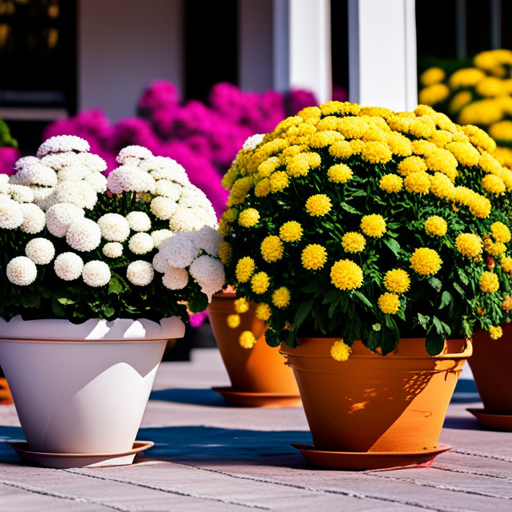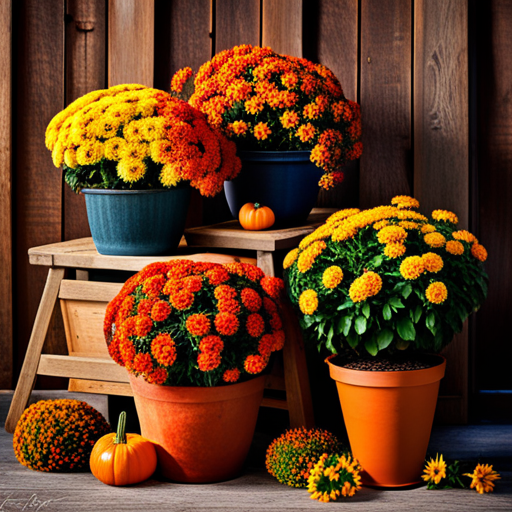
Chrysanthemums, often called “mums,” are the stars of the fall garden. These bold and colorful flowers bring life to containers, flower beds, and borders when most other plants are fading. With a wide range of shapes, sizes, and vibrant colors, chrysanthemums add beauty and charm to your outdoor space from late summer through the first frost. Whether you grow them in the ground or in pots, mums are easy to care for if you know the basics. This guide will walk you through the different types of chrysanthemums and how to grow them for a full season of autumn blooms.
Types of Chrysanthemums
Mums come in many forms, and each variety has its own unique shape and petal style. Understanding the different types can help you choose the right ones for your space and desired look.
1. Garden Mums (Hardy Mums):
These are the most popular mums for fall gardens. Hardy mums can survive light frosts and return year after year if planted early enough to establish roots. They grow well in garden beds or large containers and come in a range of colors like orange, yellow, red, pink, and white.
2. Florist Mums (Tender Mums):
These are usually sold as decorative indoor plants or in seasonal displays. While they have stunning blooms and a wider variety of flower forms, they are not cold-hardy and won’t survive frost outdoors unless brought inside.
3. Decorative Mums:
These include cushion, daisy, and button mums. They have full, rounded shapes and make great mounding plants in beds or pots. Their blooms cover the entire plant and create a lush display.
4. Spider Mums:
With long, thin petals that twist and curl, spider mums add a dramatic touch to fall gardens. They’re more often found in florist displays but can be grown outdoors in mild climates or in protected areas.
5. Quill and Spoon Mums:
These are more unique varieties with petals that either look like tubes (quill) or have a spoon-like shape at the tip. They bring texture and interest to any garden or container display.
Now that you know the types of chrysanthemums, let’s move on to how to care for them whether you plant them in the ground or in pots.
How to Grow Chrysanthemums in the Ground
Planting mums in your garden beds can give you lasting color every fall. To get the best blooms and ensure your plants return each year, follow these simple steps.
Soil Preparation:
Start by choosing a well-draining spot with rich soil. Chrysanthemums hate soggy roots, so amend your soil with compost or aged manure before planting. If your soil is heavy clay, mix in some sand or perlite to improve drainage.
Sunlight Requirements:
Mums need full sun to bloom well. Choose a location that receives at least six hours of direct sunlight each day. Too much shade will result in leggy growth and fewer flowers.
Planting Time:
Plant hardy mums in spring or early summer so they have enough time to establish strong roots before fall. If you buy mums in bloom during fall, enjoy them for the season, but treat them as annuals unless you live in a warm climate.
Watering:
Mums need consistent moisture, especially when newly planted. Water at the base of the plant to keep leaves dry and reduce the risk of mildew. Once established, water when the top inch of soil feels dry.
Fertilizing:
Feed your chrysanthemums with a balanced fertilizer every 3 to 4 weeks from spring until mid-summer. Stop fertilizing by late July to avoid encouraging new growth that won’t have time to harden off before cold weather arrives.
Pinching Back for Fullness:
To encourage bushier plants and more blooms, pinch back the tips of each stem when the plant reaches about 6 inches tall. Repeat this every few weeks until mid-July. This keeps the plant compact and filled with buds.
Mulching and Winter Care:
After the first frost, wait until the plant turns brown, then cut it back to about 3–4 inches. Cover with mulch or straw to protect the roots over winter. In spring, remove the mulch and watch for new shoots.
How to Grow Chrysanthemums in Pots
Growing chrysanthemums in containers is a great way to bring color to patios, porches, and entryways. Potted mums offer flexibility and can be rearranged or replaced easily for a fresh look all season.
Choosing the Right Pot:
Select a container with drainage holes to prevent soggy soil. A 10 to 12-inch pot works well for a single plant, but you can also mix several colors in a larger container. Use terra cotta, ceramic, plastic, or even decorative baskets lined with plastic.
Potting Mix:
Use a high-quality potting mix that drains well but holds moisture. Avoid garden soil in containers because it can compact and lead to root rot.
Planting:
Gently remove your mum from its nursery pot and loosen the roots. Set it into the container so the crown sits slightly above the soil line. Fill in around the root ball and press down gently to remove air pockets.
Watering:
Potted mums dry out faster than those in the ground. Water whenever the top inch of soil feels dry, and always let excess water drain away. Be careful not to let the pot sit in standing water.
Fertilizing:
If you plan to keep your mums for several weeks, feed them every 2 to 3 weeks with a liquid flower fertilizer. This will extend blooming and keep plants healthy.
Deadheading and Pruning:
Remove faded blooms to encourage new ones. Use scissors or your fingers to snip off dead flowers. This will keep your plant looking fresh and promote a longer blooming season.
Protection from Frost:
If an early frost is in the forecast, bring your pots indoors or cover them overnight. While hardy mums tolerate light frost, sudden freezes can damage potted plants more easily.
Display Ideas for Mums
Chrysanthemums are one of the most versatile fall flowers. Use them to brighten up your garden beds, line your walkway, or fill containers with seasonal charm. You can also combine them with other fall plants like ornamental cabbage, pansies, asters, or kale. Try grouping pots of mums in different colors for a dramatic display on your porch steps or deck.
Mums also look fantastic when planted in hay bales or hollowed-out pumpkins for a creative autumn arrangement. Use rustic containers like wooden crates, galvanized tubs, or old watering cans to create a cozy farmhouse look.
Common Problems and Solutions
Even though mums are easy to grow, a few issues may pop up. Here’s how to handle them.
Powdery Mildew:
This shows up as white patches on leaves and stems. Avoid overhead watering and provide good air circulation. If needed, treat with a mild fungicide.
Aphids and Mites:
Small insects can gather on flower buds and leaves. Spray with insecticidal soap or neem oil if you notice pests.
Leggy Growth:
If your mums are tall and spindly, it means they need more sun or more frequent pinching in the growing season.
Poor Blooming:
Lack of flowers usually comes from too much shade or not pinching early in the season. Make sure plants are getting enough light and are properly pruned.
Final Thoughts
Chrysanthemums are a must-have for fall gardens. Their wide range of shapes, sizes, and brilliant colors make them a top choice for gardeners and decorators alike. Whether you plant them in the ground for long-term beauty or use them in containers for instant impact, mums are easy to care for with just a bit of attention. Prepare the soil, choose the right location, water consistently, and deadhead as needed. With these simple steps, you’ll enjoy a burst of autumn color that lasts through the season and returns year after year in the garden.
By choosing the right type of chrysanthemum and giving it proper care, you can transform your outdoor space into a vibrant fall display. So go ahead—fill your garden beds and porches with colorful mums this season and enjoy one of the easiest and most rewarding ways to celebrate fall.
Please be sure to check out my Gardening Blog Post Page for more tips on all types of gardening. Including Seed Saving, Seed Starting, Orchids, Water Gardening, Coldframe Gardening, Indoor Bulb Gardening, Hydroponics, Container Gardening, Mums, Herbs, African Violets, planting Bulbs, Flower Gardening, Vegetable and Fruit Gardening, Indoor Houseplants of all kinds, Bonsai, Cactus, Succulents, Hanging plants, Deer resistant plants and even Bird, Bee, Butterfly and Hummingbird Gardens!

